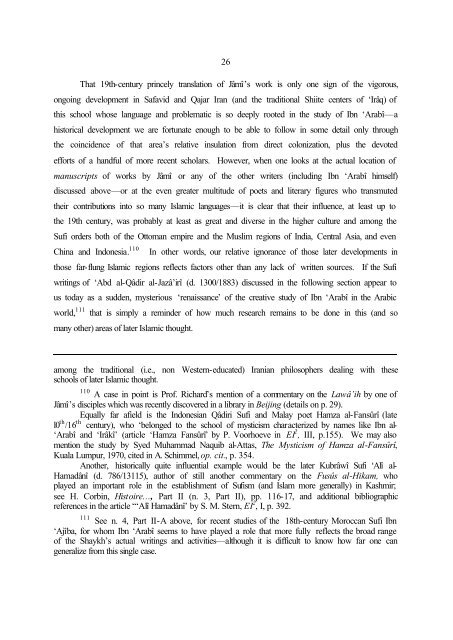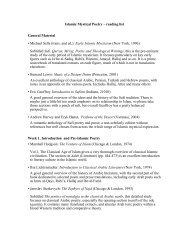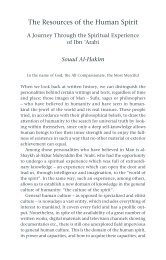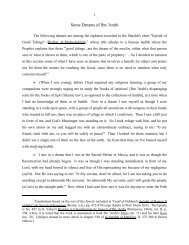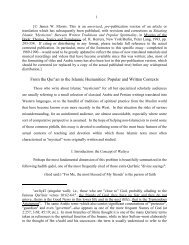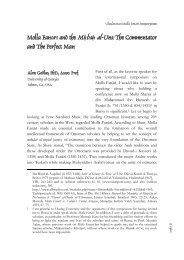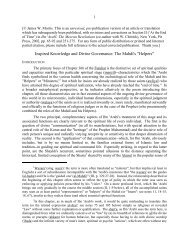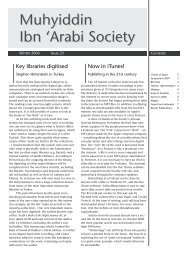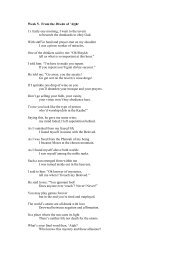Part III (pdf) - Muhyiddin Ibn Arabi Society
Part III (pdf) - Muhyiddin Ibn Arabi Society
Part III (pdf) - Muhyiddin Ibn Arabi Society
Create successful ePaper yourself
Turn your PDF publications into a flip-book with our unique Google optimized e-Paper software.
26That 19th-century princely translation of Jâmî’s work is only one sign of the vigorous,ongoing development in Safavid and Qajar Iran (and the traditional Shiite centers of ‘Irâq) ofthis school whose language and problematic is so deeply rooted in the study of <strong>Ibn</strong> ‘Arabî—ahistorical development we are fortunate enough to be able to follow in some detail only throughthe coincidence of that area’s relative insulation from direct colonization, plus the devotedefforts of a handful of more recent scholars. However, when one looks at the actual location ofmanuscripts of works by Jâmî or any of the other writers (including <strong>Ibn</strong> ‘Arabî himself)discussed above—or at the even greater multitude of poets and literary figures who transmutedtheir contributions into so many Islamic languages—it is clear that their influence, at least up tothe 19th century, was probably at least as great and diverse in the higher culture and among theSufi orders both of the Ottoman empire and the Muslim regions of India, Central Asia, and evenChina and Indonesia. 110 In other words, our relative ignorance of those later developments inthose far-flung Islamic regions reflects factors other than any lack of written sources. If the Sufiwritings of ‘Abd al-Qâdir al-Jazâ’irî (d. 1300/1883) discussed in the following section appear tous today as a sudden, mysterious ‘renaissance’ of the creative study of <strong>Ibn</strong> ‘Arabî in the <strong>Arabi</strong>cworld, 111 that is simply a reminder of how much research remains to be done in this (and somany other) areas of later Islamic thought.among the traditional (i.e., non Western-educated) Iranian philosophers dealing with theseschools of later Islamic thought.110 A case in point is Prof. Richard’s mention of a commentary on the Lawâ’ih by one ofJâmî’s disciples which was recently discovered in a library in Beijing (details on p. 29).Equally far afield is the Indonesian Qâdiri Sufi and Malay poet Hamza al-Fansûrî (latel0 th /16 th century), who ‘belonged to the school of mysticism characterized by names like <strong>Ibn</strong> al-‘Arabî and ‘Irâkî’ (article ‘Hamza Fansûrî’ by P. Voorhoeve in EI 2 , <strong>III</strong>, p.155). We may alsomention the study by Syed Muhammad Naquib al-Attas, The Mysticism of Hamza al-Fansûrî,Kuala Lumpur, 1970, cited in A. Schimmel, op. cit., p. 354.Another, historically quite influential example would be the later Kubrâwî Sufi ‘Alî al-Hamadânî (d. 786/13115), author of still another commentary on the Fusûs al-Hikam, whoplayed an important role in the establishment of Sufism (and Islam more generally) in Kashmir;see H. Corbin, Histoire…, <strong>Part</strong> II (n. 3, <strong>Part</strong> II), pp. 116-17, and additional bibliographicreferences in the article “‘Alî Hamadânî’ by S. M. Stern, EI 2 , I, p. 392.111 See n. 4, <strong>Part</strong> II-A above, for recent studies of the 18th-century Moroccan Sufi <strong>Ibn</strong>‘Ajîba, for whom <strong>Ibn</strong> ‘Arabî seems to have played a role that more fully reflects the broad rangeof the Shaykh’s actual writings and activities—although it is difficult to know how far one cangeneralize from this single case.


